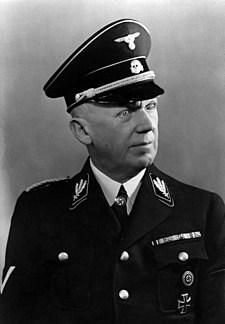Hugo Boss (businessman)
Hugo Ferdinand Boss | |
|---|---|
| Born | Hugo Ferdinand Boss 8 July 1885 |
| Died | 9 August 1948 (aged 63) Metzingen, Germany |
| Nationality | German |
| Occupations |
|
| Known for | Founding Hugo Boss Luxury clothing company |
| Political party | Nazi Party |
Hugo Ferdinand Boss (8 July 1885 – 9 August 1948)[citation needed] was a German fashion designer and businessman. He was the founder of the clothing company Hugo Boss AG. He was an active member of the Nazi Party as early as 1931 and remained loyal to the Nazi German ideology throughout the duration of the party's existence.
Early life
Boss was born in Metzingen, Kingdom of Württemberg, to Luise (née Münzenmayer) and Heinrich Boss,[1] the youngest of five children. He apprenticed as a merchant, did his military service from 1903 to 1905, and then worked in a weaving mill in Konstanz. He took over his parents' lingerie shop in Metzingen in 1908, as heir.[citation needed] In 1914, he was mobilized into the army and served through World War I, ending it as a corporal.[citation needed]
Personal life
Boss married Anna Katharina Freysinger in 1908. They had one daughter.[citation needed]
Hugo Boss company
Boss founded his own clothing company in Metzingen in 1923 and then opened a factory in 1924, initially with two partners. The company produced shirts and jackets and later work clothing, sportswear, and raincoats. In the 1930s, it produced uniforms for the SA, the SS,[2] the Hitler Youth, the postal service, the national railroad, and later the Wehrmacht.[3]
Support of Nazism

Boss joined the Nazi Party in 1931, two years before Adolf Hitler came to power.[4] By the third quarter of 1932, the all-black SS uniform (to replace the SA brown shirts) was designed by SS-Oberführer Prof. Karl Diebitsch, graphic designer Walter Heck, who had no affiliation with the company.[5][6] The Hugo Boss company produced these black uniforms along with the brown SA shirts and the black-and-brown uniforms of the Hitler Youth.[7][8] Some workers were French and Polish prisoners of war forced into labour.[9][10] In 1999, US lawyers acting on behalf of Holocaust survivors started legal proceedings against the Hugo Boss company over the use of slave labour during the war.[11] The misuse of 140 Polish and 40 French forced workers led to an apology by the company.[12]
After World War II, the denazification process saw Boss initially labeled as an "activist, supporter and beneficiary" of National Socialism, which resulted in a heavy fine, also stripping him of his voting rights and of his capacity to run a business. However, this initial ruling was appealed, and Boss was re-labeled as a "follower", a category with a less severe punishment.[4] Nevertheless, the effects of the ban led to Boss's son-in-law, Eugen Holy, taking over both the ownership and the running of the company.
Death
Boss died of a tooth abscess in 1948.[10]
References
- ^ "Hugo Ferdinand Boss". Geneall.net.
- ^ Lumsden, Robin. A Collector's Guide To: The Allgemeine - SS, Ian Allan Publishing, Inc. 2001, p 53.
- ^ "Hugo Boss comes clean on Nazi past". The Local. 2011-09-21. Archived from the original on 2017-03-23.
- ^ a b "Hugo Boss Biography".
- ^ McNab, Chris. Hitler's Elite: The SS 1939–45, Osprey 2013, p 90.
- ^ "Hugo Boss apology for Nazi past as book is published". BBC News. BBC. 21 September 2011. Retrieved 2 October 2018.
- ^ "Hugo Boss Acknowledges Link to Nazi Regime". The New York Times. 1997-08-15. Retrieved 2008-09-25.
- ^ White, Constance C. R. "Patterns: Dealing with Hugo Boss's Nazi tie." The New York Times 19 August 1997: A20.
- ^ Givhan, Robin (1997-08-15). "Clothier Made Nazi Uniforms". Los Angeles Times. Retrieved 2008-11-08.
- ^ a b (in German) Zwangsarbeit in Metzingen (Forced Work in Metzingen), Ch.7: Die Firma Hugo Boss
- ^ Hall, Allan (May 15, 1999). "Hugo Boss facing Holocaust lawsuit". Daily Record. Glasgow, Scotland. Retrieved 2011-10-03.
- ^ Abramovitch, Seth. "Hugo Boss Apologizes For Making Nazis Look Fabulous". Archived from the original on 28 March 2013. Retrieved 4 April 2013.
